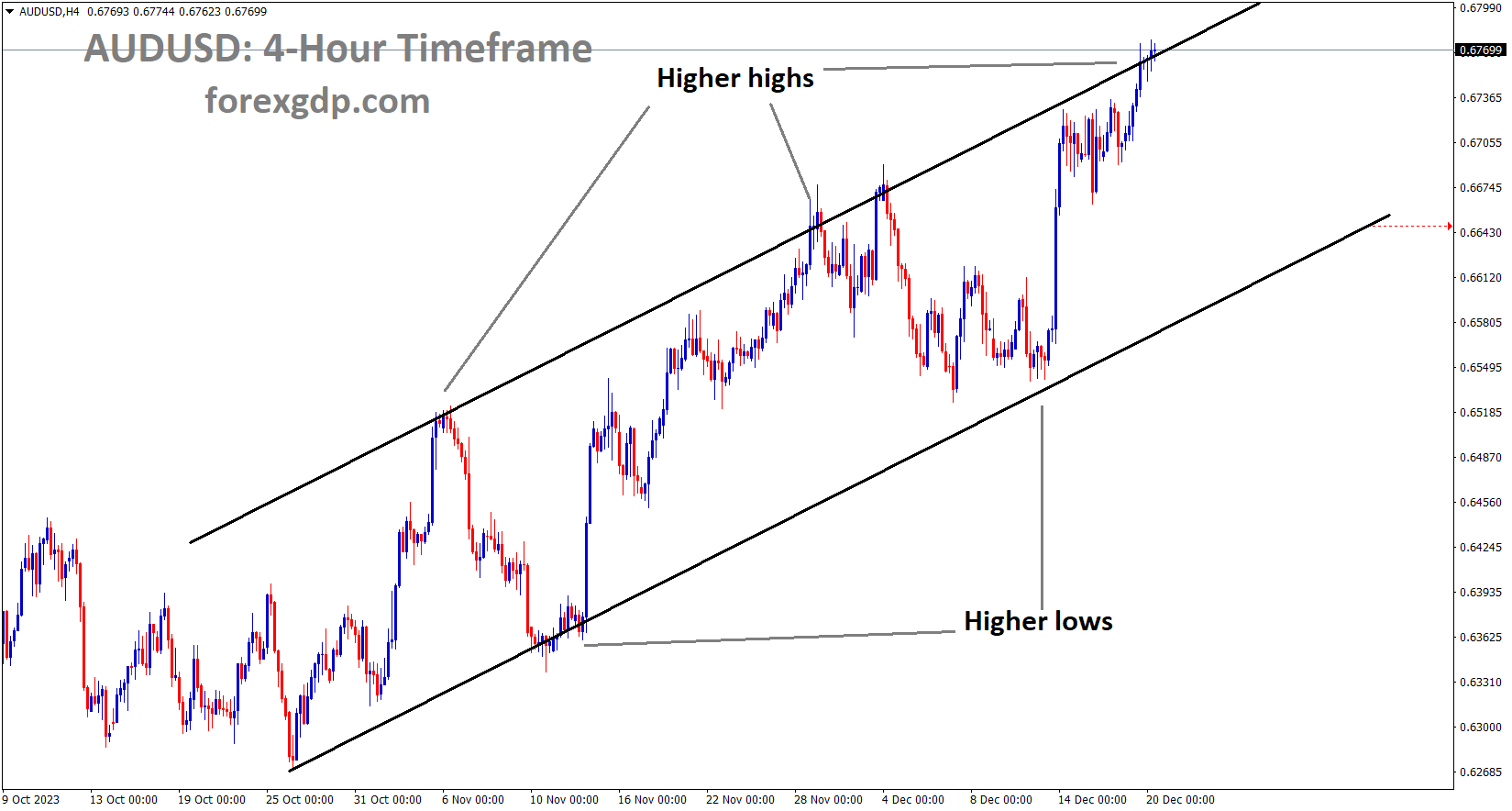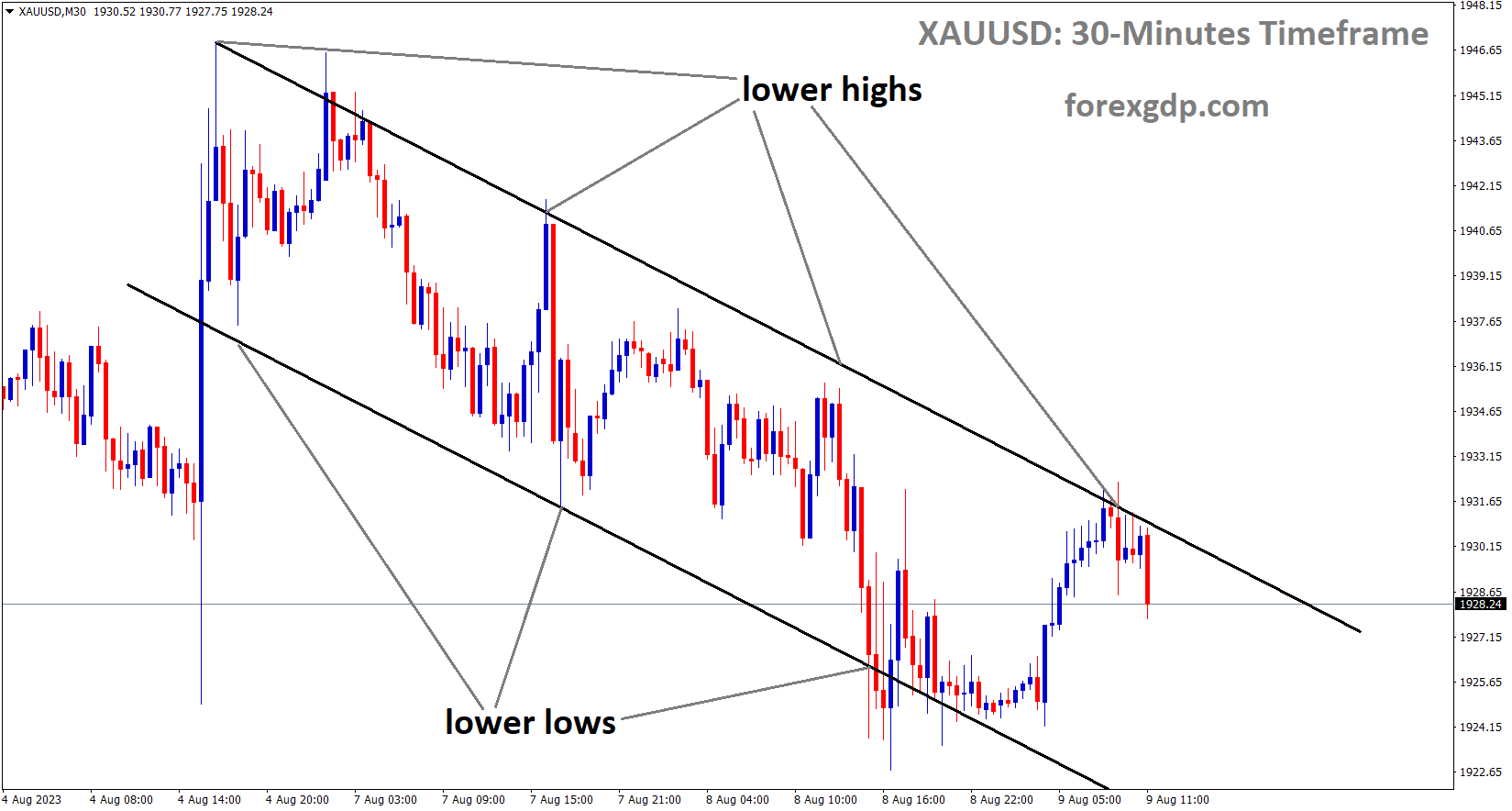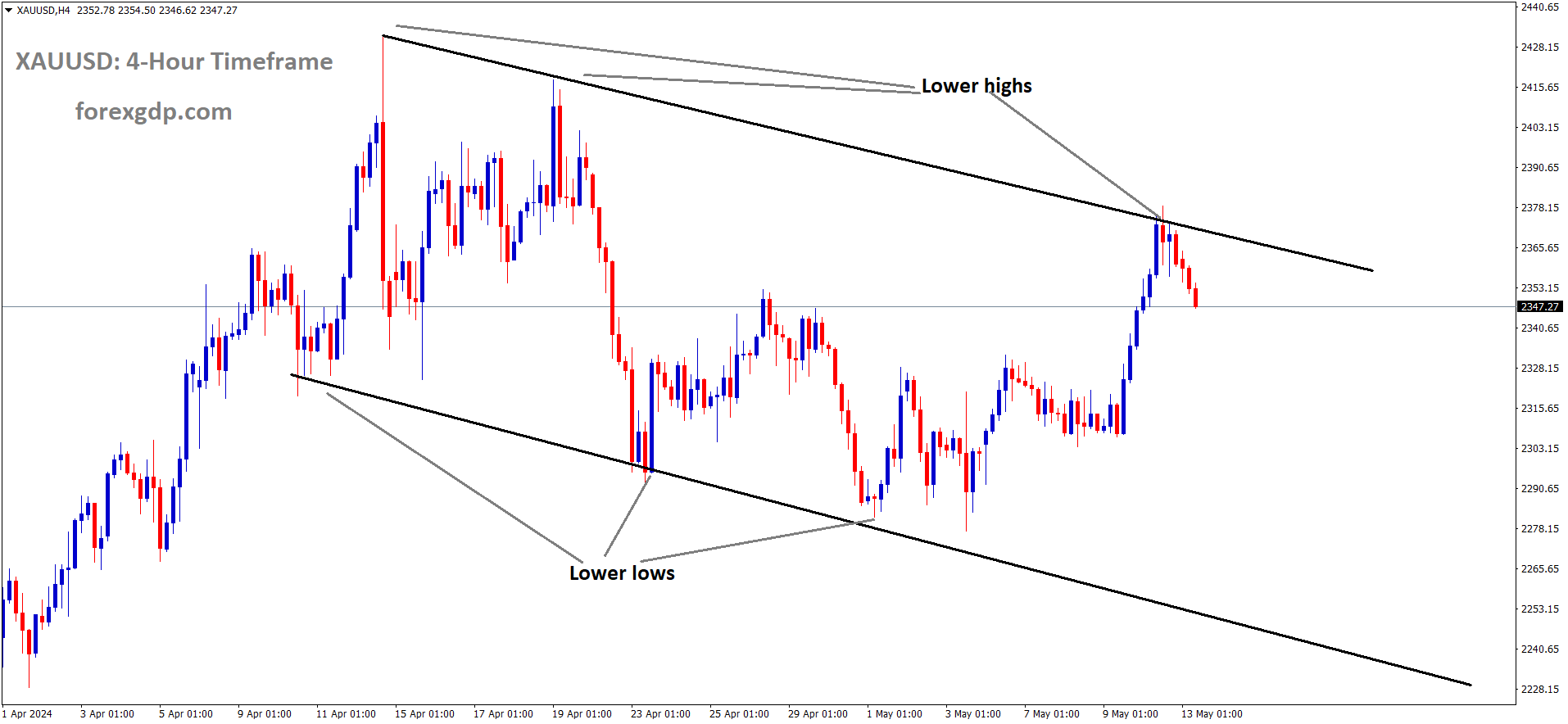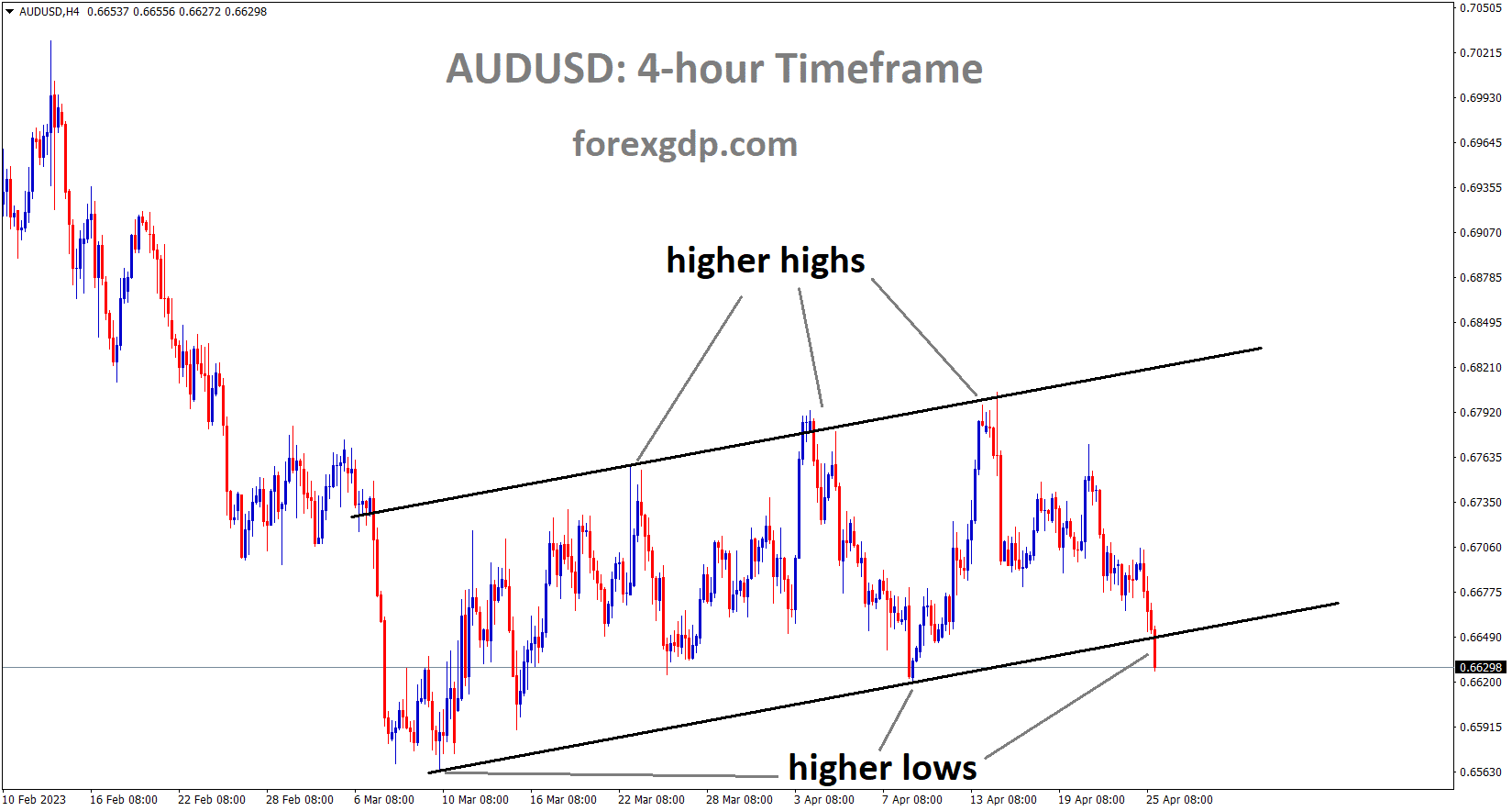AUDUSD Analysis:
AUDUSD is moving in an Ascending channel and the market has reached the higher high area of the channel
The Australian Dollar is on an upward trajectory following the release of the RBA meeting minutes, which have instilled confidence in the possibility of rate hikes. However, the decision to hold rates will be contingent on upcoming data. The RBA remains committed to managing inflation and is prepared to take the necessary measures to achieve that goal.
The People’s Bank of China has decided to keep interest rates steady at 3.45% for one year and 4.20% for five years today. Consequently, the Australian Dollar surged in value following this announcement.
The latest US housing data, released on Tuesday, presented a mixed picture. Housing Starts exceeded expectations by reaching 1.56 million, surpassing the market consensus of 1.36 million. Conversely, Building Permits fell to 1.46 million, which was worse than the anticipated 1.47 million. Following the Federal Open Market Committee meeting last week, market sentiment suggests that the US central bank has completed its tightening cycle and may consider rate cuts in the coming year. This development has put downward pressure on the US Dollar and provided support for the AUDUSD pair. According to CME’s Fed Watch tool, financial markets are pricing in a 67.5% probability that the Federal Reserve will implement a 25 basis point rate cut as early as March.

In contrast, the Reserve Bank of Australia, in its December minutes, indicated the possibility of raising interest rates in response to encouraging signs of decreasing inflationary pressures across the economy. However, the central bank emphasized that its policy decisions will hinge on incoming data and the evolving assessment of risks. Looking ahead, traders will closely monitor the release of US Existing Home Sales on Wednesday. Later in the week, attention will shift to the release of the third-quarter US Gross Domestic Product Annualized, which is expected to remain steady at 5.2%. On Friday, the focus will be on the Core Personal Consumption Expenditures Price Index.
On Wednesday, the People’s Bank of China made an announcement confirming that it has decided to keep the Loan Prime Rate unchanged across all maturity periods. Specifically, the Chinese central bank has maintained the one-year LPR at 3.45% and the five-year LPR at 4.20%.
GOLD Analysis:
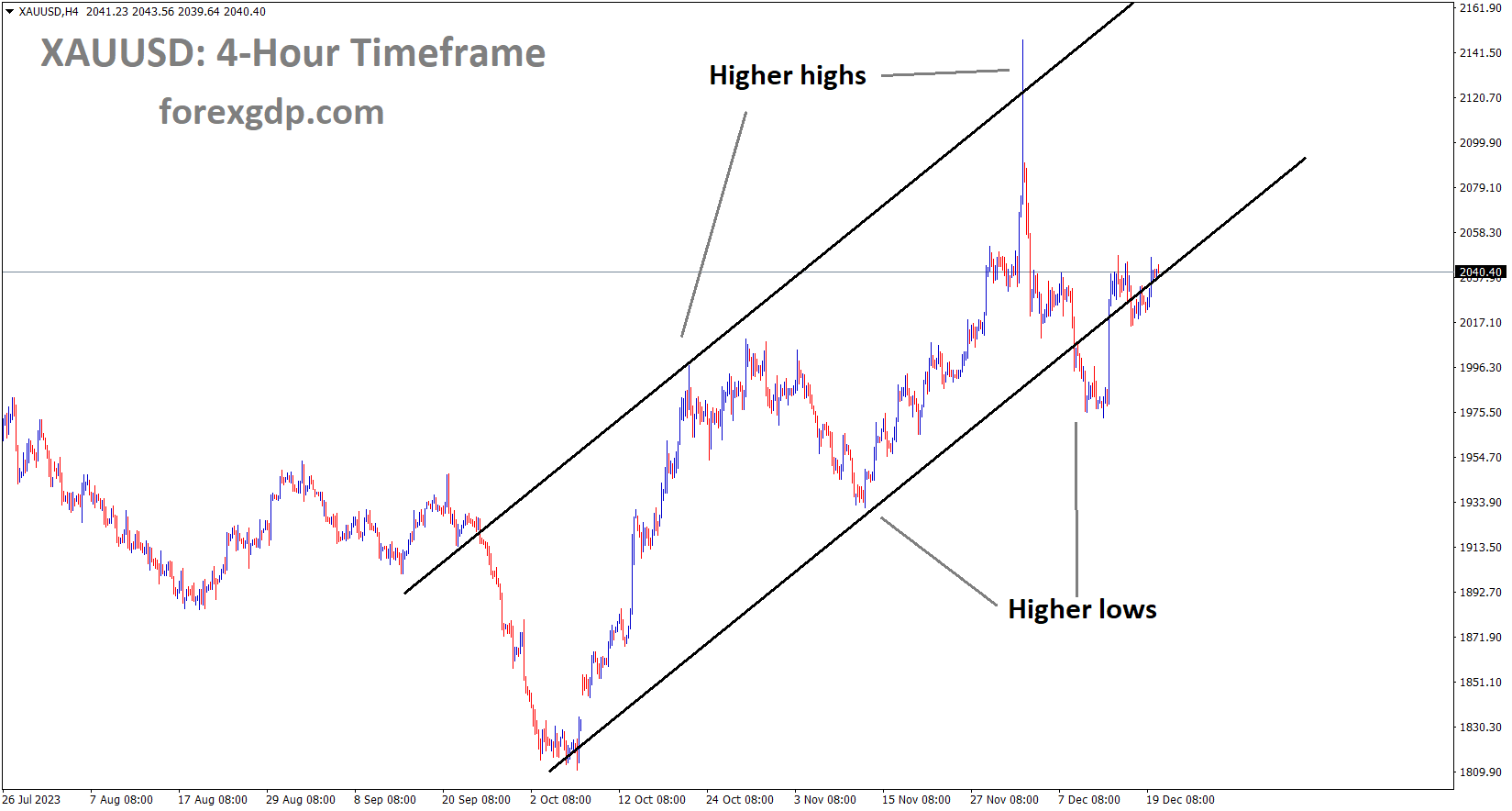
XAUUSD Gold price is moving in an Ascending channel and the market has rebounded from the higher low area of the channel
During his remarks last week, Fed Chair Powell stated that the period of rate hikes is concluded for this year, and the possibility of rate cuts next year remains on the table, subject solely to data-driven decisions. In response to these expectations of potential rate cuts by the Fed, gold prices surged.
During the past week, Federal Reserve Chair Jerome Powell made comments suggesting that the tightening cycle had come to an end, leaving the door open for potential policy easing in the coming year. Powell mentioned that discussions regarding rate cuts had already commenced. However, on the following Friday, New York Fed President John Williams expressed a different viewpoint, raising the question of whether monetary policy was restrictive enough or not.

Despite these differing views, money market futures have priced in more than 135 basis points of rate cuts for December 2024, according to fed funds futures contracts on the Chicago Board of Trade. Additionally, there is a 70% likelihood of a rate cut in March.
Meanwhile, according to sources cited by Reuters, investors have been acquiring gold, and there is less motivation to divest from it. This sentiment arises from the belief that the Federal Reserve might opt to cut interest rates before achieving its 2% inflation target. Regarding economic data, recent US housing statistics were robust but did not significantly impact the favorability of the US Dollar. Looking ahead to the coming week, the US economic calendar is set to become busier with the release of final Q3 GDP data, followed by Durable Goods Orders, the core PCE, and additional housing data.
SILVER Analysis:
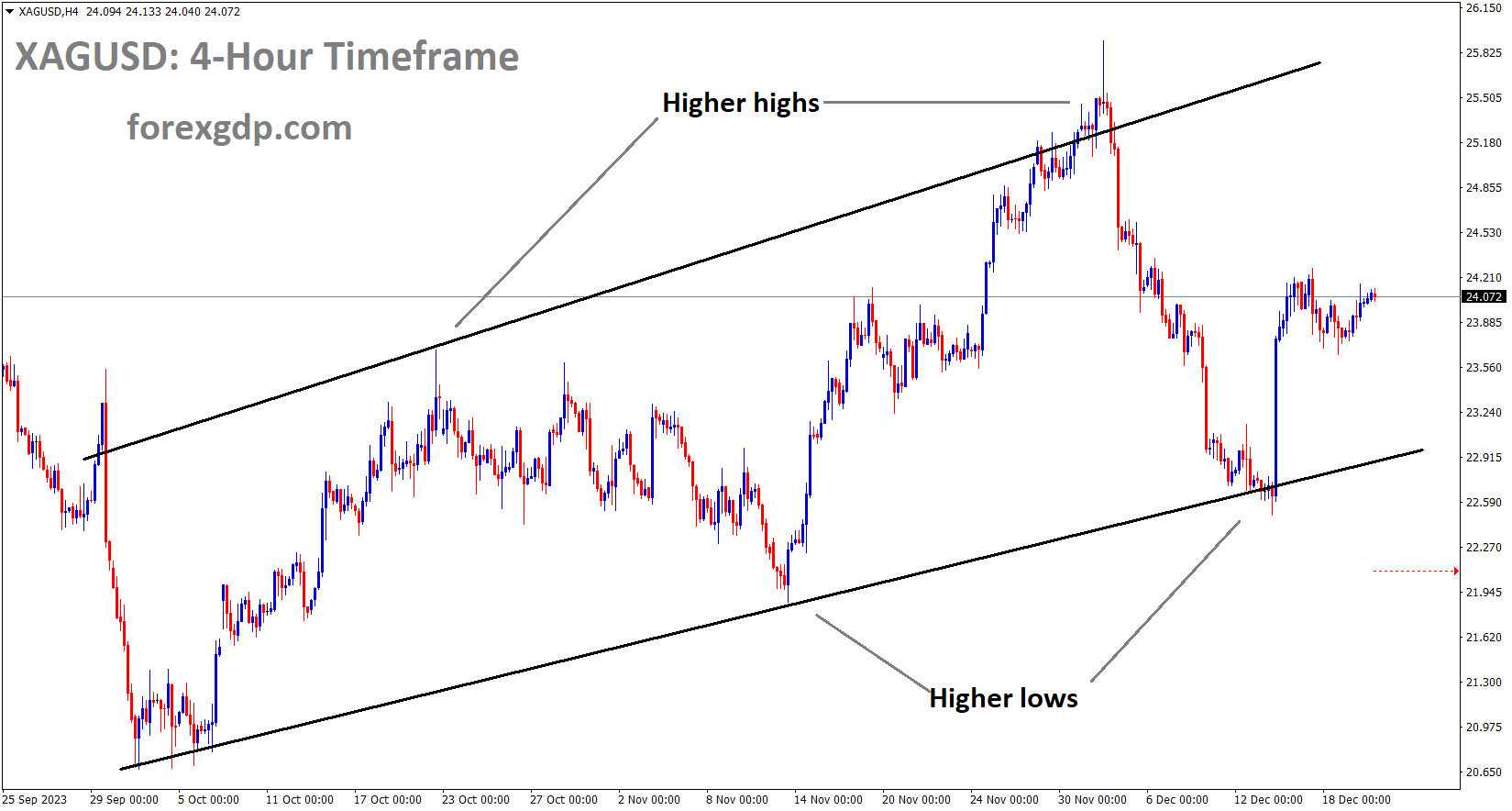
XAGUSD Silver price is moving in an Ascending channel and the market has rebounded from the higher low area of the channel
Chicago Fed President Austan Goolsbee emphasized that rate adjustments, whether cuts or increases, should not be driven by market euphoria or sentiment. The Federal Reserve’s decisions regarding rate changes are instead grounded in data and inflation trends, irrespective of whether the market is bullish or bearish.

In a Wednesday morning interview with Fox TV, Austan Goolsbee, President of the Federal Reserve Bank of Chicago, expressed his concern that the market’s enthusiasm for anticipated interest rate cuts may be premature. He emphasized that if inflation continues to decrease, the Federal Reserve could potentially reassess its level of restraint. Goolsbee underlined that the Federal Reserve’s decisions are not influenced by political factors; instead, the key determinant for the possibility of reducing restraint is the trajectory of inflation. He also cautioned against allowing market sentiments to pressure or influence the Federal Reserve’s decisions.
USDJPY Analysis:
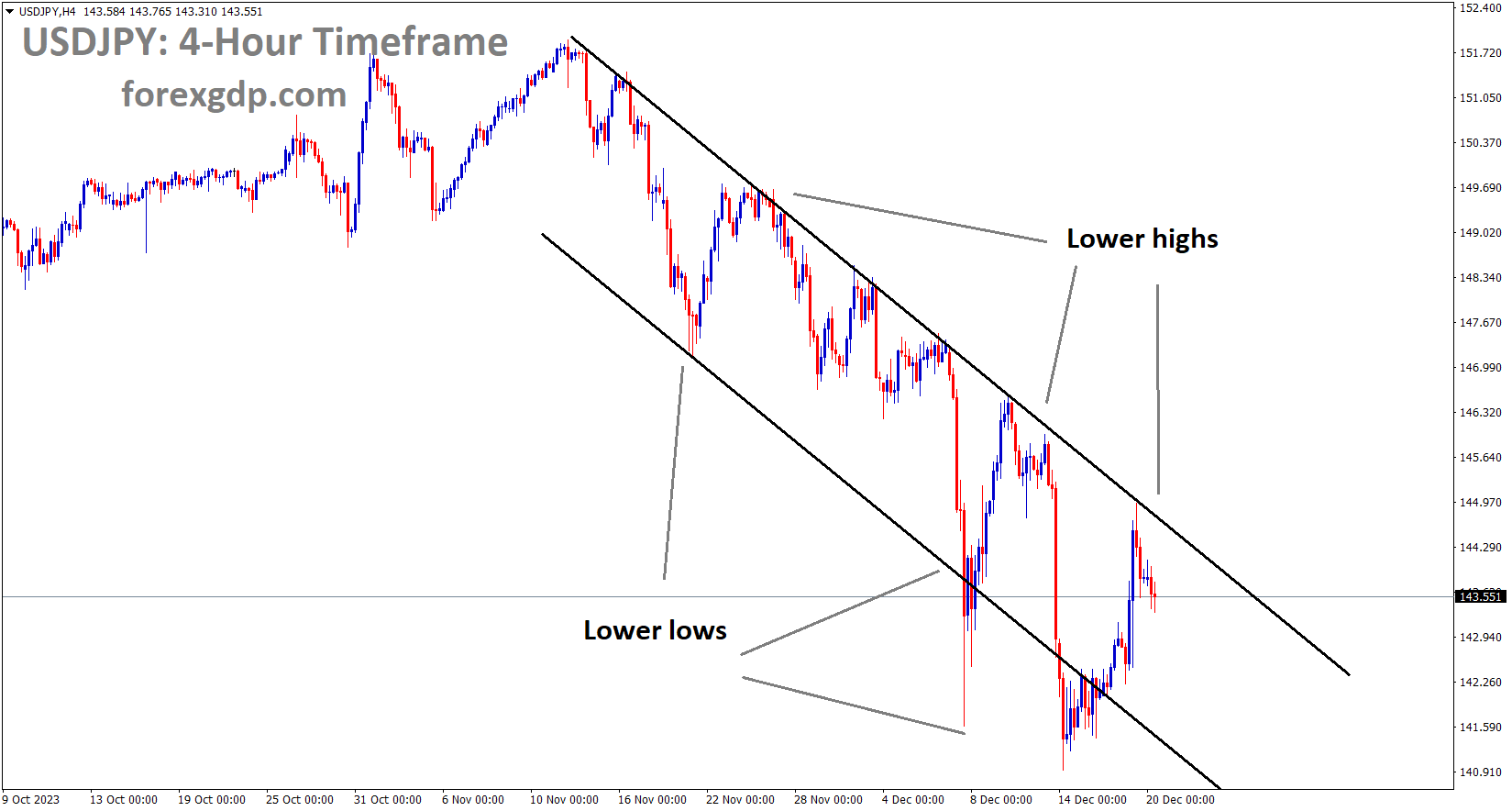
USDJPY is moving in the Descending channel and the market has fallen from the lower high area of the channel
The Japanese Yen depreciated against the USD as the Bank of Japan reiterated its commitment to maintaining negative interest rates and implementing further policy adjustments if necessary. Despite expectations, the Bank of Japan stood firm in its decision to leave interest rates unchanged.
On Tuesday, the Bank of Japan made the decision to maintain its extremely loose monetary policy without any adjustments. This move disappointed some investors who were hoping for a signal that the central bank might soon shift away from negative interest rates. Additionally, data released on Wednesday revealed that both imports and exports in Japan had declined more than expected in November. This, coupled with a generally positive sentiment in the equity markets, is expected to weaken the safe-haven status of the Japanese Yen. In contrast, the US Dollar is attracting buyers due to uncertainty surrounding when the Federal Reserve will begin reducing interest rates, providing some support for the USDJPY pair. Traders are also cautious about making aggressive directional bets ahead of a crucial US inflation report.
The US Core Personal Consumption Expenditure Price Index, which is the preferred inflation gauge of the Federal Reserve, is scheduled for release on Friday. This data is expected to influence the Fed’s future policy decisions, which will play a significant role in driving demand for the USD and providing a clear direction for the USDJPY pair. In the meantime, short-term trading opportunities will be influenced by the Conference Board’s Consumer Confidence Index, Existing Home Sales data, and an appearance by Chicago Fed President Austan Goolsbee during the North American session on Wednesday.

Concerns about the Federal Reserve potentially initiating rate cuts by the first half of 2024 are continuing to weigh on the US Dollar, leading to some selling in the USD/JPY pair on Wednesday. In an interview with Fox TV, Chicago Fed President Austan Goolsbee cautioned that the markets may be getting ahead of themselves, emphasizing that the central bank should not be swayed by market expectations. On Tuesday, the US Census Bureau reported a substantial increase in Housing Starts by 14.8% in November to 1.56 million units, while Building Permits declined by 2.5% after a 1.8% rise in October. Despite this data, USD bulls appear unmoved, as influential members of the Federal Open Market Committee have recently pushed back against the market’s anticipation of early interest rate cuts in 2024.
To sum it up, the Bank of Japan has chosen to maintain its ultra-loose monetary policy, leaving negative interest rates unchanged, potentially weakening the Japanese Yen. Analysts are now dismissing the possibility of a policy shift by the BoJ in January, as monetary tightening is deemed unhelpful for the economy and not particularly desirable in theory. Furthermore, recent trade data shows a narrowed trade deficit for Japan in November, with imports dropping by 11.9% and exports declining by 0.2%, largely due to weak Chinese demand. The prevailing risk-on sentiment in the market may further diminish the JPY’s safe-haven appeal and help limit significant downsides for the USDJPY pair. Traders are eagerly awaiting the release of the Conference Board’s Consumer Confidence Index, but the primary focus remains on the critical US inflation reading, the US Core PCE Price Index, scheduled for Friday.
USDCAD Analysis:
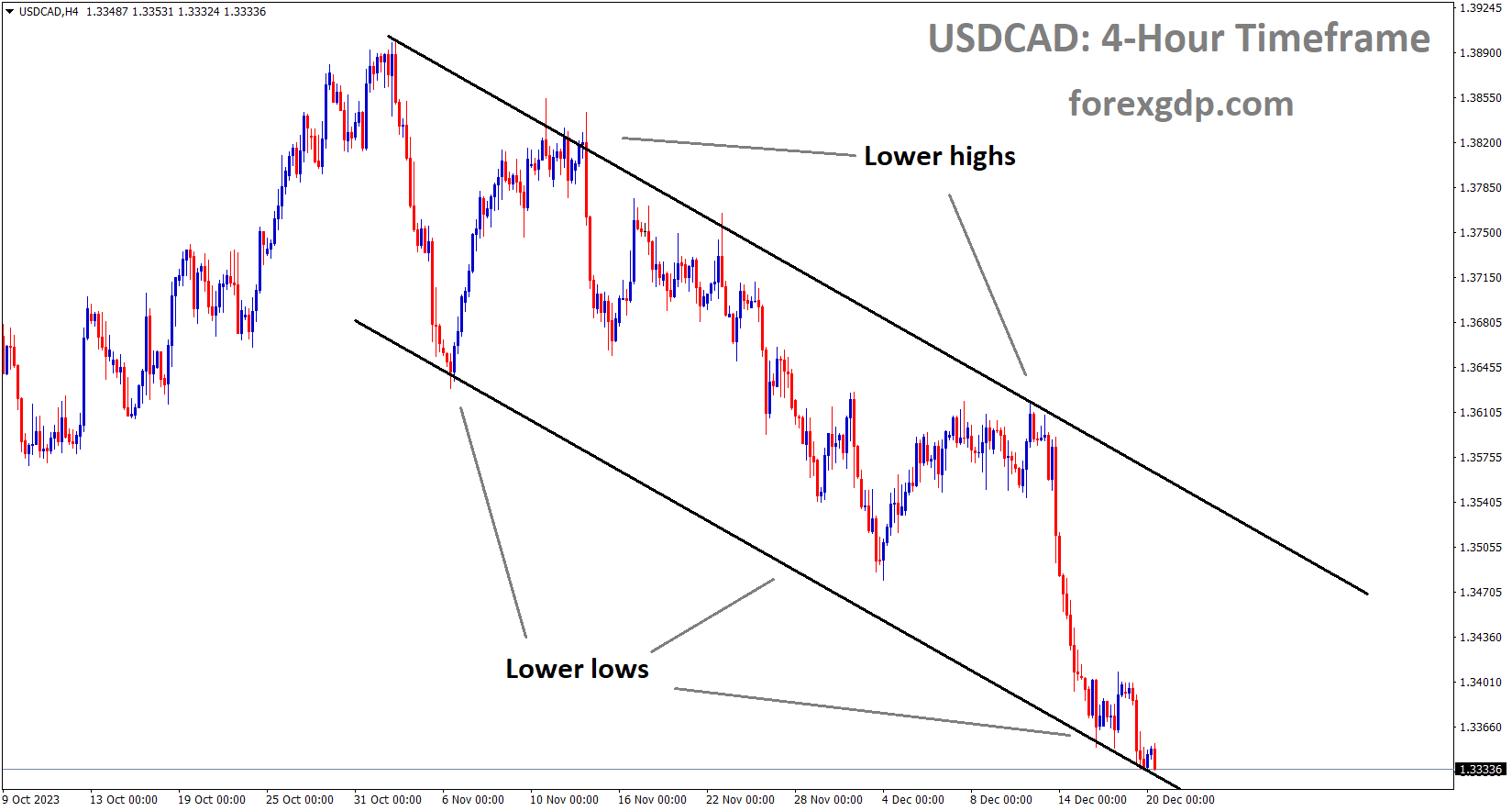
USDCAD is moving in the Descending channel and the market has reached the lower low area of the channel
The Canadian inflation rate remained unchanged at 3.1% in November, suggesting that the Bank of Canada might maintain steady interest rates for a few more months. Consequently, the Canadian Dollar gained strength against its counterpart currencies.
The annual consumer inflation rate in Canada surprisingly remained stable at 3.1% in November, leading traders to reconsider their expectations for when the Bank of Canada might initiate interest rate cuts. This development, coupled with the recent moderate recovery in Crude Oil prices from their lowest point since late June earlier this month, could continue to support the commodity-linked Canadian Dollar. Additionally, the prevailing bearish sentiment surrounding the US Dollar may further constrain the USDCAD currency pair. The Federal Reserve adopted a more dovish stance last week and forecasted an average of three 25 basis points rate reductions in 2024. This, combined with the ongoing risk-on market sentiment, has kept the safe-haven US Dollar near its lowest level in over four months, reached last Friday.

Despite this, several influential Fed officials have recently attempted to downplay speculations about an imminent dovish shift in the US central bank’s policy stance, although their efforts have had limited impact on bolstering the USD bulls. Market participants are now turning their attention to the US economic calendar, which includes the release of the Conference Board’s Consumer Confidence Index and Existing Home Sales data. These releases, along with the scheduled appearance of Chicago Fed President Austan Goolsbee, will shape the demand for the US Dollar during the North American session and provide fresh momentum to the USDCAD pair. In addition, traders will be closely monitoring Oil price movements for short-term trading opportunities. Nevertheless, the primary focus will remain on the US Core PCE Price Index, the Federal Reserve’s preferred inflation gauge, which is scheduled for release on Friday.
USDCHF Analysis:
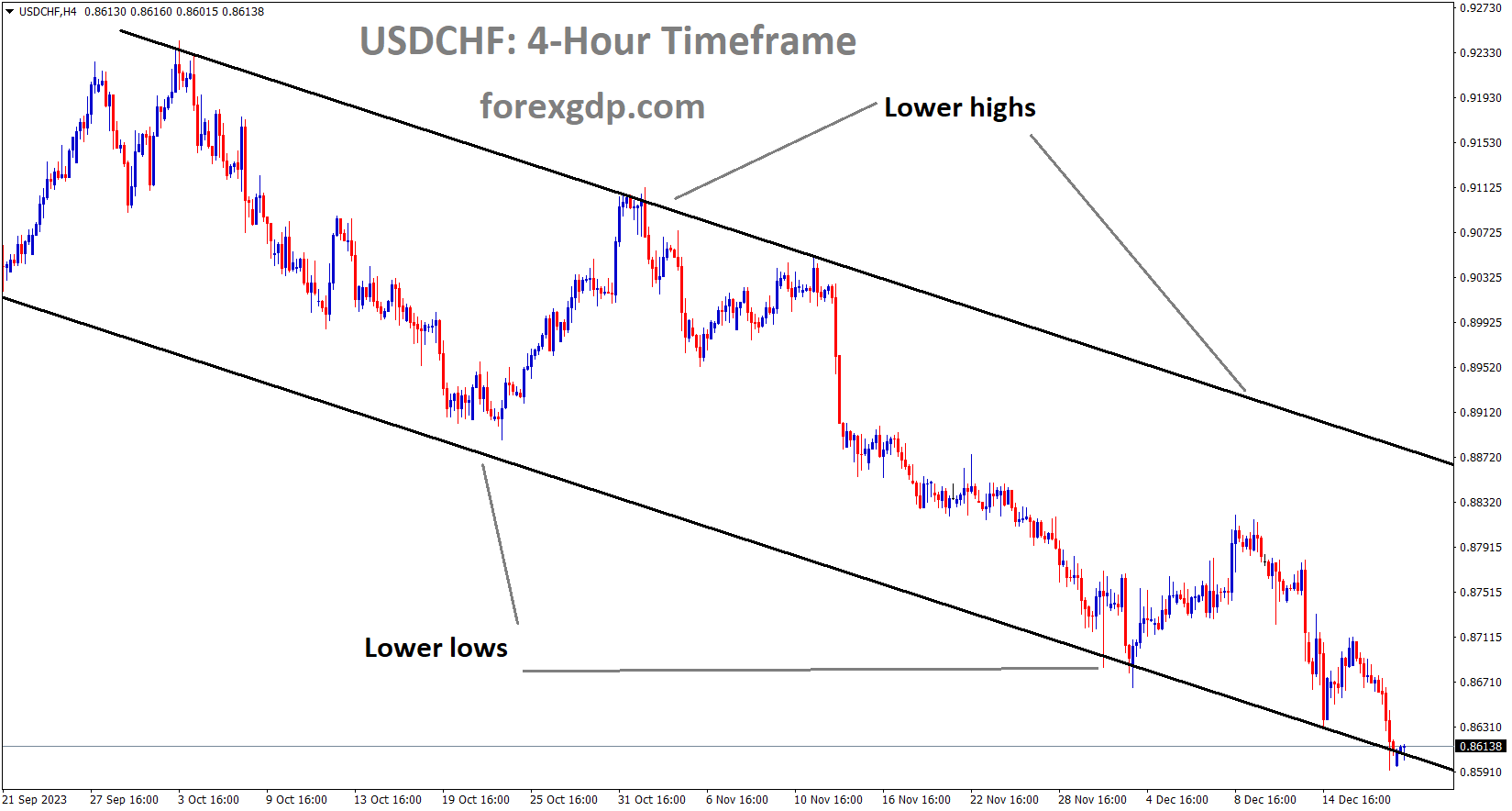
USDCHF is moving in the Descending channel and the market has reached the lower low area of the channel
Similar to the Eurozone economy, the Swiss economy is experiencing a decline in business confidence and domestic data following the interest rate hike by the Swiss National Bank . The SNB’s Q4 Bulletin report is expected later this week. Meanwhile, the US Dollar remains weak in the market due to ongoing rate cuts and the prevailing market euphoria.

During last Wednesday’s meeting, it was indicated that there likely won’t be any further tightening, and the revised dot plots showed that bank officials were forecasting a 75 basis points easing in 2024. Since then, the US Dollar has been under selling pressure, with any dovish guidance adding to the downward pressure on the Greenback. In alignment with this sentiment, Thomas Barkin commented on Tuesday that if inflation continues to decline, the Federal Reserve will respond, fueling expectations of further easing. On the contrary, Raphael Bostic from the Atlanta Fed sounded more cautious and emphasized the need for a resolute and patient policy, forecasting only two rate cuts in 2024.
GBPCHF Analysis:
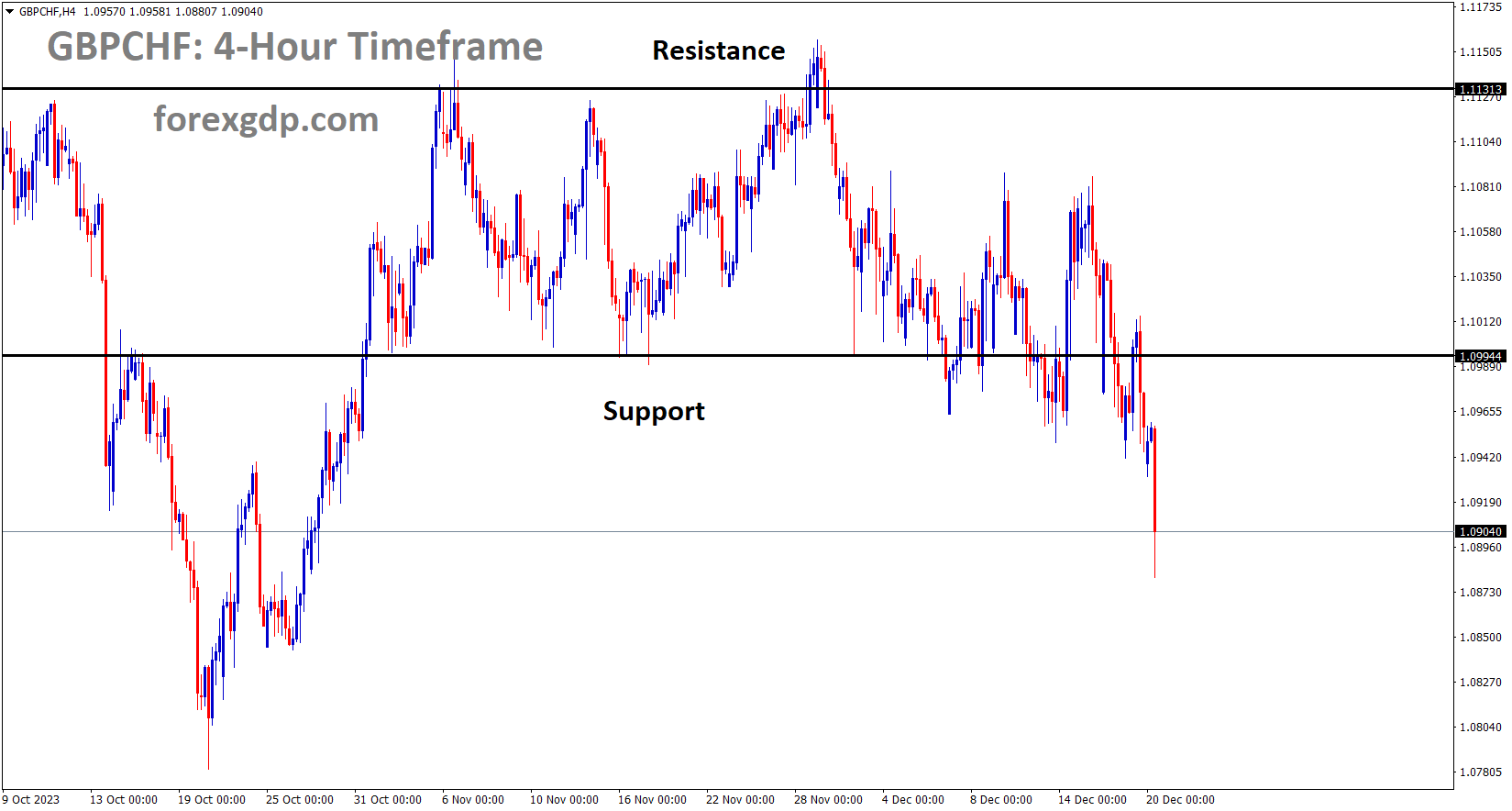
GBPCHF has broken the Box pattern in downside
Currently, US bond yields are trading lower, with the 2-year rate at 4.40%, and the 5 and 10-year rates standing at 3.94% and 3.92%, respectively. This downward trend in US yields is contributing to the pair’s decline as the US Dollar loses its appeal.
However, the Swiss economy, like much of Europe, is experiencing contraction, marked by declining business confidence and investment, especially in energy-intensive industries. These factors could potentially strengthen the USD against the Swiss Franc, given the relative strength of the American economy. On Wednesday, investors will be closely monitoring the Swiss National Bank Quarterly Bulletin for Q4 to gain further insights into the Swiss economy.
GBPCAD Analysis:
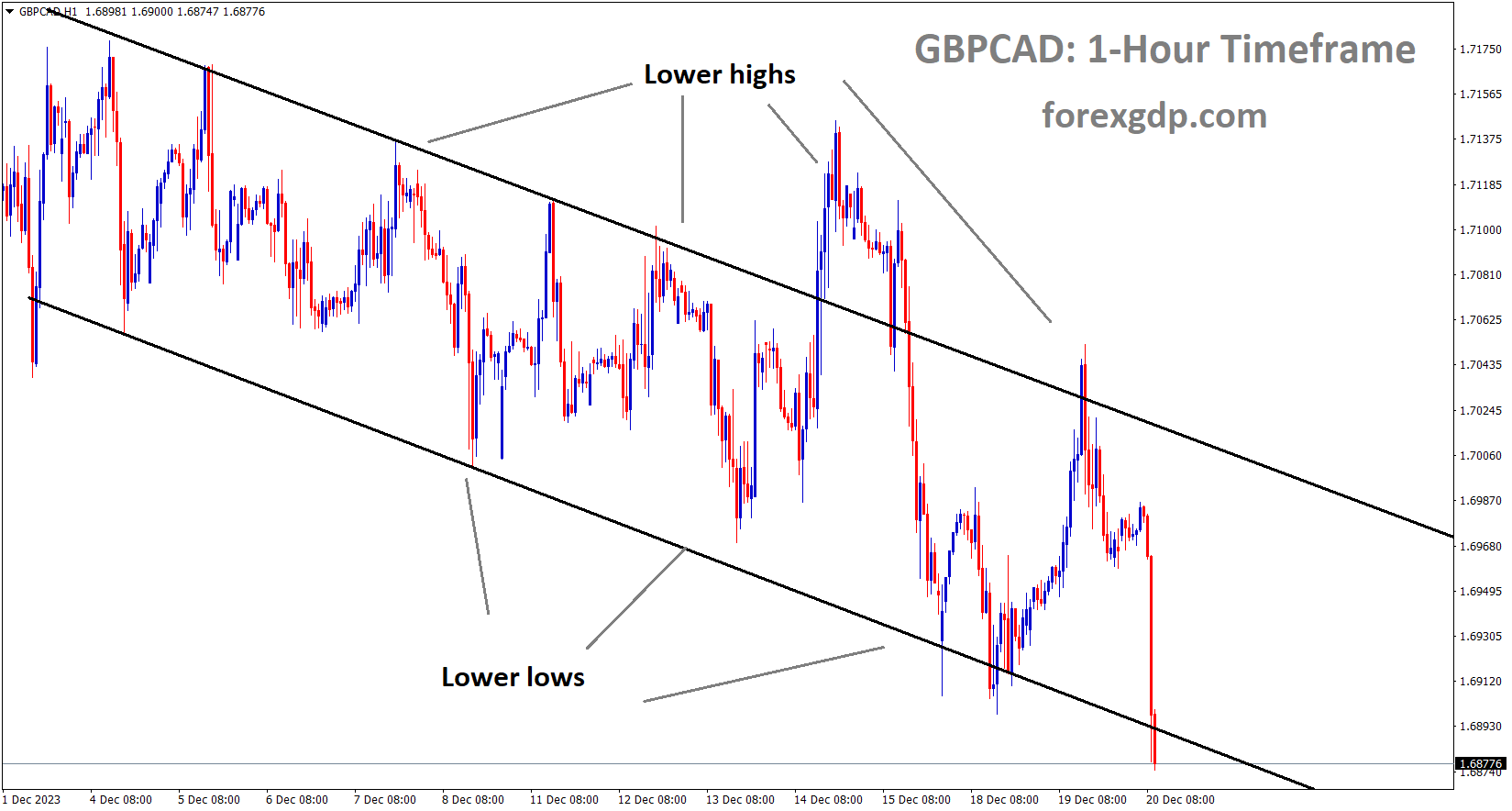
GBPCAD is moving in the Descending channel and the market has reached the lower low area of the channel
The UK inflation data for November showed a decrease to 3.9% from the 4.6% recorded in October, leading to a sharp decline in the value of the GBP following the announcement.
According to the Office for National Statistics’ latest data released on Wednesday, the United Kingdom’s Consumer Price Index showed a year-on-year increase of 3.9% in November.

This marks a decrease from the 4.6% rise observed in October, which was lower than the market’s anticipated acceleration of 4.4%. Furthermore, the Core CPI, which excludes volatile food and energy items, experienced a year-on-year increase of 5.1% in November, in contrast to the 5.7% growth seen in October and falling short of the expected 5.6%. In addition, the UK Consumer Price Index registered a 0.2% month-on-month decrease in November, contrary to the expected 0.1% increase and the zero percent change recorded in October.
EURGBP Analysis:
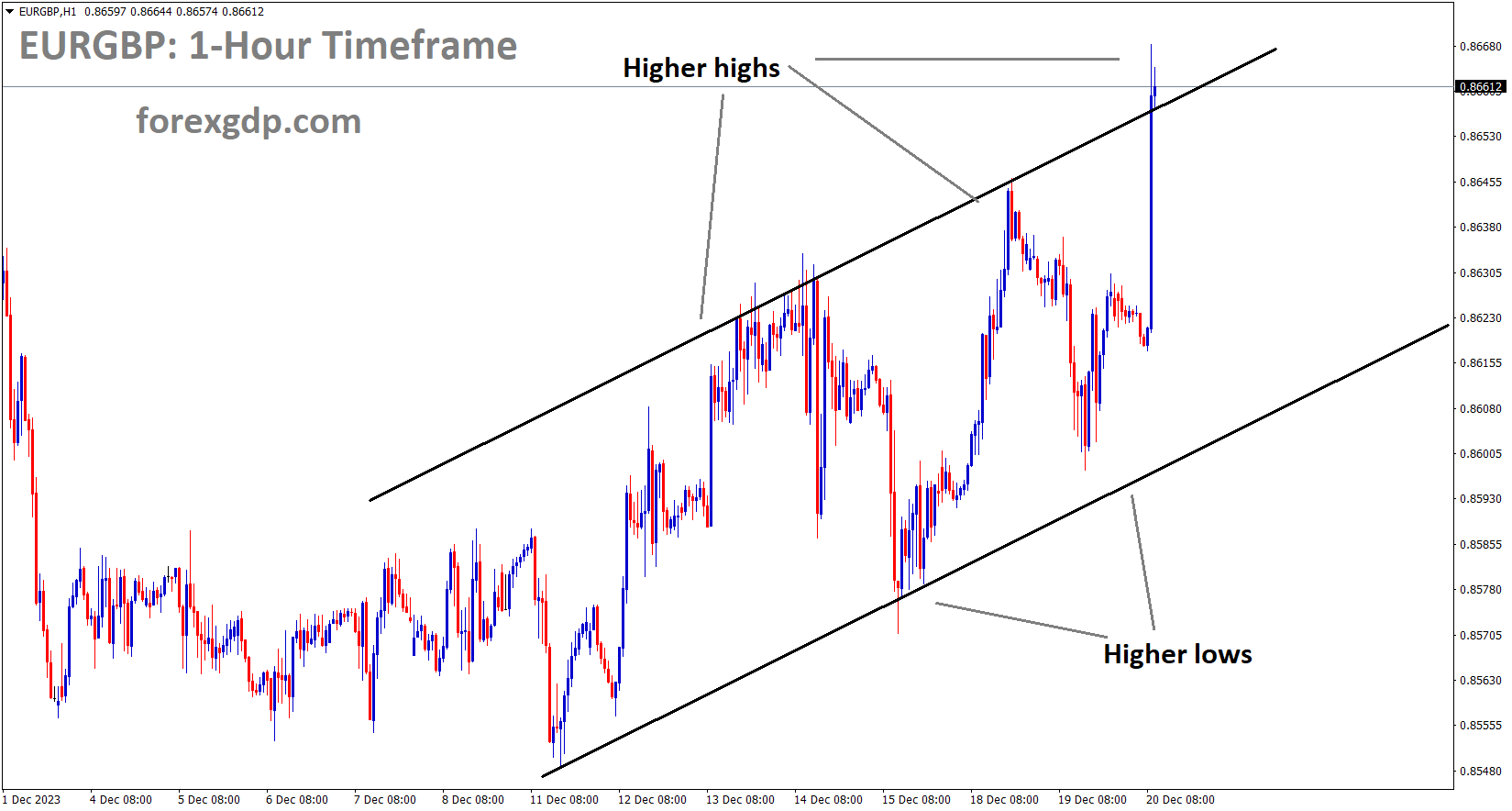
EURGBP is moving in an Ascending channel and the market has reached the higher high area of the channel
The Eurozone CPI data for November, which stood at 2.4%, has raised concerns for the Euro currency, leading to its depreciation against other currencies. The European Central Bank has indicated no intention of implementing rate cuts in the upcoming meetings.
Data released by Eurostat on Tuesday revealed that Eurozone inflation for November fell short of market expectations due to a decline in energy prices. The Eurozone Harmonized Index of Consumer Prices for November showed a month-on-month decrease of -0.6%, compared to the -0.5% figure from the previous month, indicating weaker performance than anticipated. However, the annual inflation rate for the Eurozone stood at 2.4%, aligning with analysts’ predictions.

Notably, the Core HICP, which excludes the volatile components of food and energy, reported a year-on-year increase of 3.6%, marking its lowest reading since April 2022. Following its recent monetary policy meeting, the European Central Bank stated that it had not discussed rate cuts. The ECB also issued a warning that inflation might spike again in December due to colder weather, which typically raises energy demand and prices. This development could potentially limit the Euro’s upward momentum and create headwinds for the EURUSD currency pair.
On the other side of the Atlantic, Building Permits in the United States dropped to 1.46 million in November, down from October’s 1.498 million, falling short of the market’s expected figure of 1.47 million. However, Housing Starts increased to 1.56 million in November, up from the previous reading of 1.359 million, surpassing the consensus estimate of 1.36 million, as reported by the US Census Bureau on Tuesday. Looking ahead to Wednesday, traders will closely monitor the release of the German Producer Price Index for November, Eurozone data including October’s Current Account and Construction Output, as well as December’s Consumer Confidence. On the US economic calendar, Existing Home Sales will be a key release of the day.
NZDUSD Analysis:
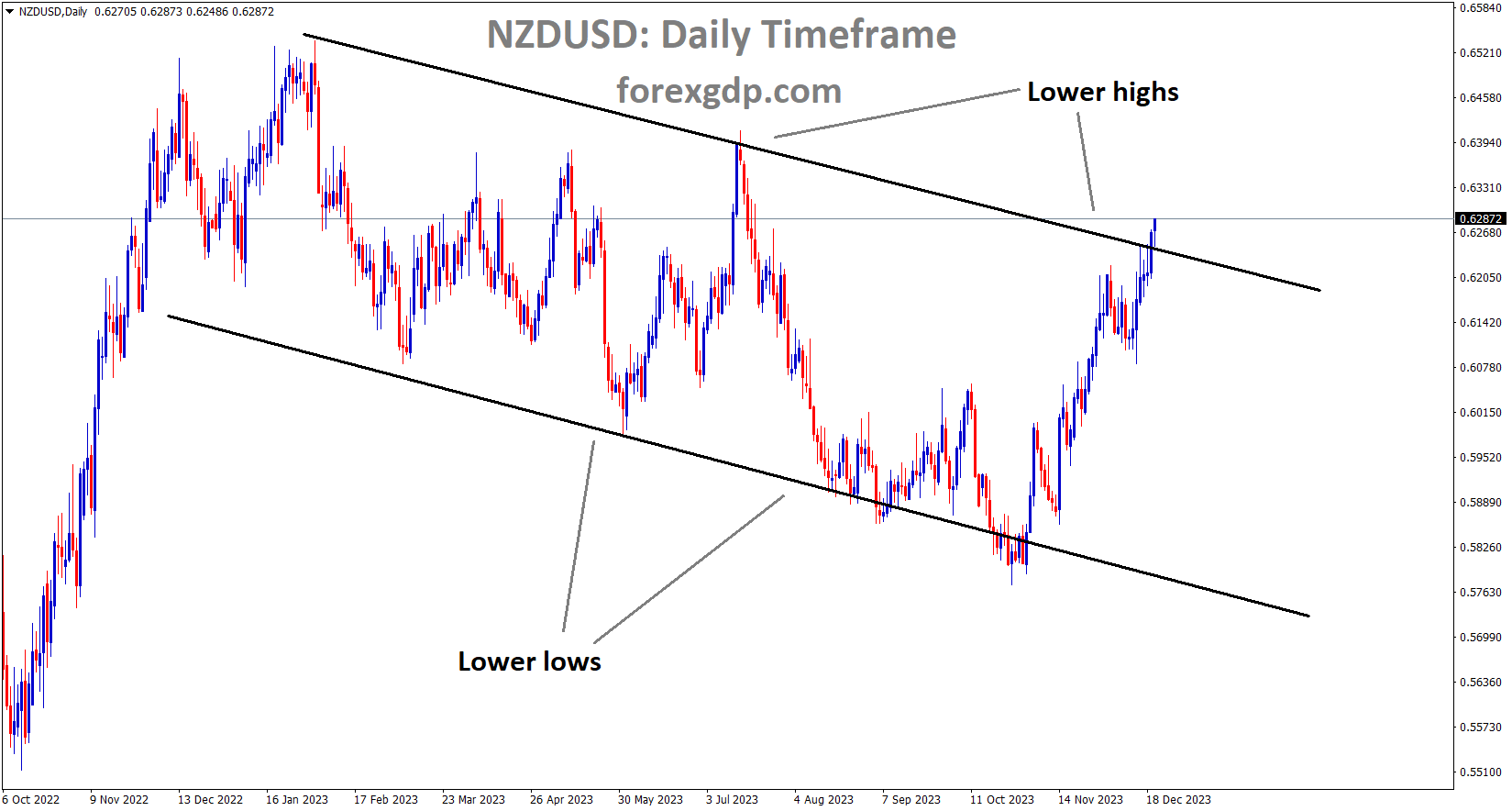
NZDUSD is moving in the Descending channel and the market has reached the lower high area of the channel
Last week, RBNZ Governor Orr expressed surprise at the lower-than-expected Q3 GDP figures, emphasizing that there is still a significant journey ahead for the inflation rate to decrease. As a result, the decision on rate hikes or cuts in upcoming meetings will be contingent on data and economic conditions.
Reserve Bank of New Zealand Governor Adrian Orr stated on Wednesday that they were taken aback by last week’s GDP data, which showed a contraction in the economy. However, he emphasized that they have not yet formed an opinion regarding its impact on the future interest rate outlook, as reported by Bloomberg.
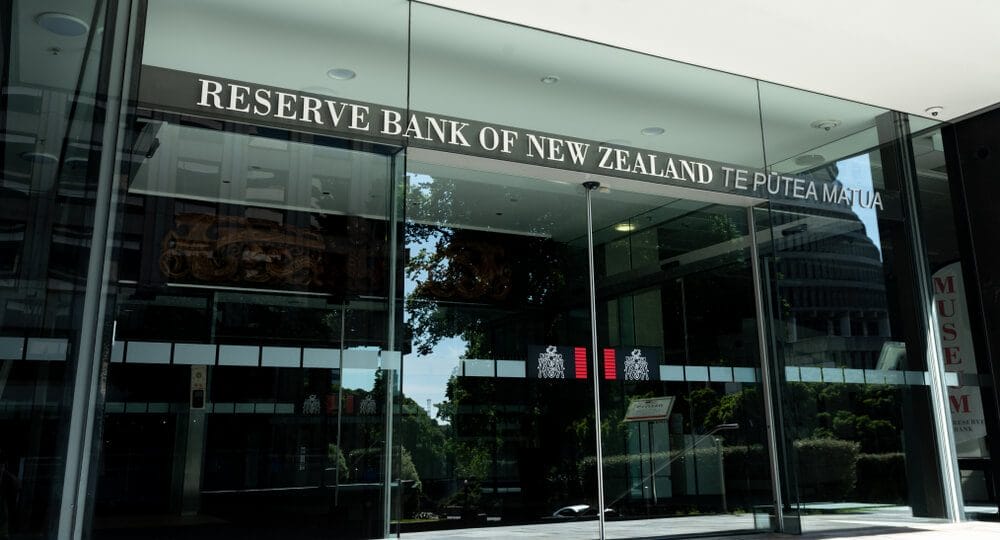
Orr acknowledged that the GDP data was unexpectedly lackluster, and they are currently carefully considering the intricate nature of the situation. He mentioned their plans to provide further insights in February through their monetary policy statement. Additionally, he expressed surprise at the sustained high levels of net inward migration.
Furthermore, Orr underscored the significance of addressing core inflation as a challenge they will encounter in the future. He pointed out that core inflation presents a notable challenge, with many aspects related to it falling under the purview of central and local government, such as rates and taxes. He recognized that the final stages of the battle against inflation are likely to be demanding, particularly in light of the persistent high levels of core inflation, or domestically generated inflation.
Don’t trade all the time, trade forex only at the confirmed trade setups.
Get more confirmed trade setups here: forexgdp.com/buy/

